Comprehensive Report on Alcohol Abuse: Healthcare Policy and Practice
VerifiedAdded on 2023/01/19
|8
|2407
|45
Report
AI Summary
This report provides an overview of alcohol abuse in the United Kingdom, highlighting its increasing prevalence and the associated challenges for healthcare organizations. It delves into the detrimental impacts of excessive alcohol consumption on both physical health, detailing short-term and long-term effects on the brain, heart, liver, pancreas, immune system, and risk of cancer, and personal life, including social, economic, and psychological consequences. The report then outlines various strategies and methods that healthcare and social care services can employ to prevent alcohol abuse and assist individuals struggling with alcoholism. These include recognizing signs of overdrinking, exploring treatment options such as alcohol detox, inpatient rehabilitation, counseling, and government-supported programs. The report concludes by emphasizing the need for proactive measures and specific actions from healthcare and social care organizations to mitigate the impact of alcohol abuse and improve public health outcomes. It underscores the importance of awareness, prevention, and accessible treatment options to address this critical public health concern.
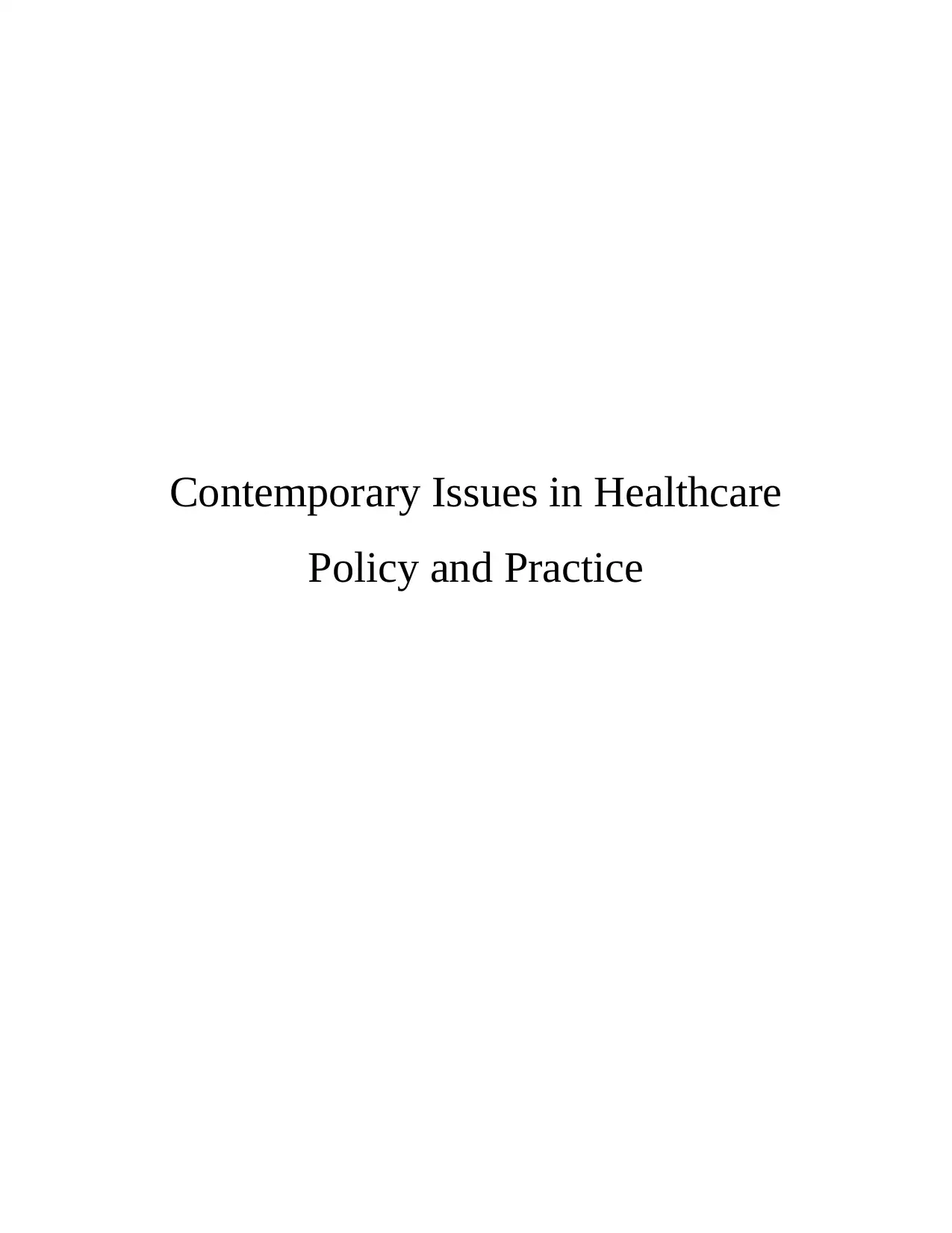
Contemporary Issues in Healthcare
Policy and Practice
Policy and Practice
Paraphrase This Document
Need a fresh take? Get an instant paraphrase of this document with our AI Paraphraser

Table of Contents
INTRODUCTION...........................................................................................................................3
Impact of alcohol abuse on health and personal life........................................................................3
CONCLUSION................................................................................................................................7
REFERENCES................................................................................................................................8
INTRODUCTION...........................................................................................................................3
Impact of alcohol abuse on health and personal life........................................................................3
CONCLUSION................................................................................................................................7
REFERENCES................................................................................................................................8
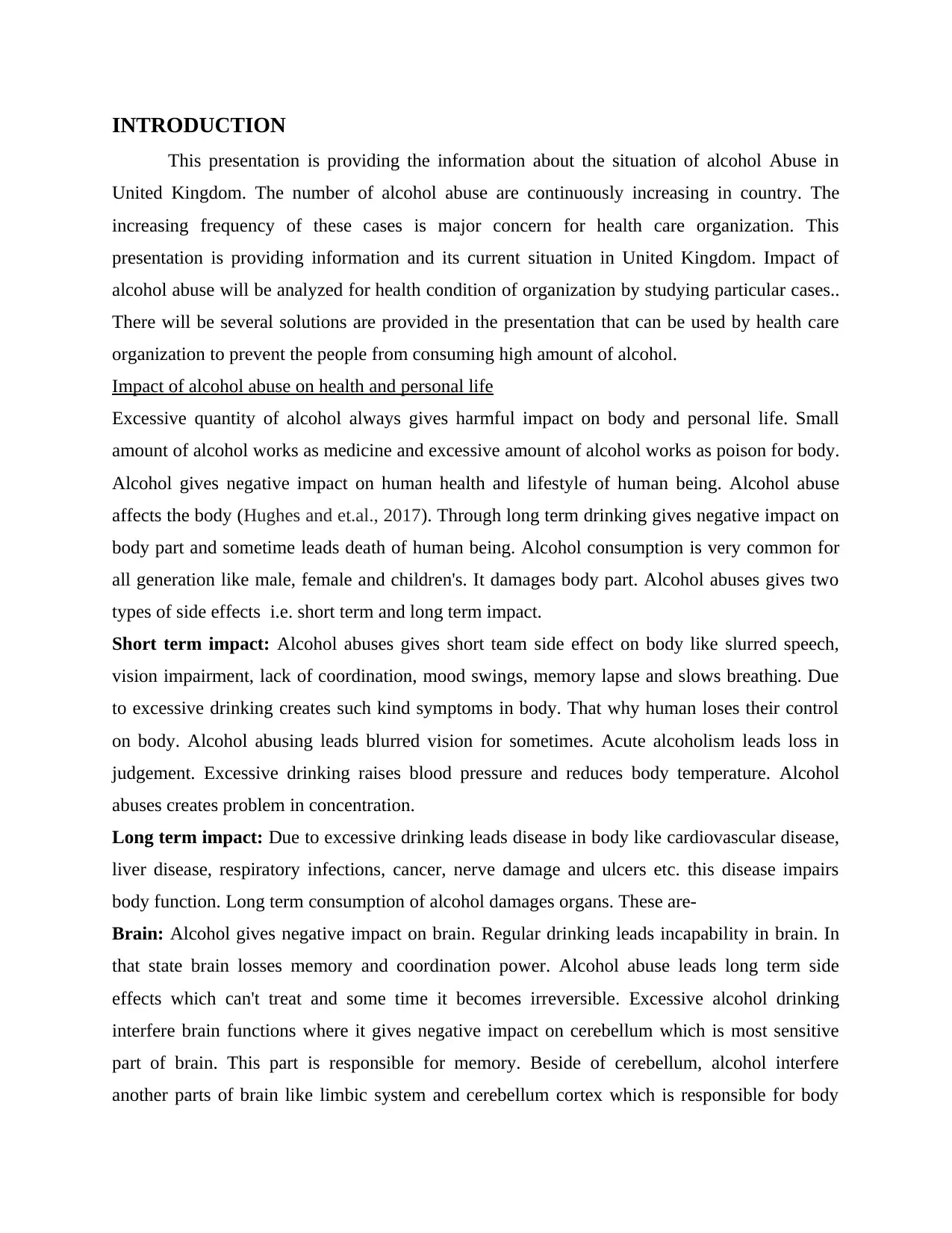
INTRODUCTION
This presentation is providing the information about the situation of alcohol Abuse in
United Kingdom. The number of alcohol abuse are continuously increasing in country. The
increasing frequency of these cases is major concern for health care organization. This
presentation is providing information and its current situation in United Kingdom. Impact of
alcohol abuse will be analyzed for health condition of organization by studying particular cases..
There will be several solutions are provided in the presentation that can be used by health care
organization to prevent the people from consuming high amount of alcohol.
Impact of alcohol abuse on health and personal life
Excessive quantity of alcohol always gives harmful impact on body and personal life. Small
amount of alcohol works as medicine and excessive amount of alcohol works as poison for body.
Alcohol gives negative impact on human health and lifestyle of human being. Alcohol abuse
affects the body (Hughes and et.al., 2017). Through long term drinking gives negative impact on
body part and sometime leads death of human being. Alcohol consumption is very common for
all generation like male, female and children's. It damages body part. Alcohol abuses gives two
types of side effects i.e. short term and long term impact.
Short term impact: Alcohol abuses gives short team side effect on body like slurred speech,
vision impairment, lack of coordination, mood swings, memory lapse and slows breathing. Due
to excessive drinking creates such kind symptoms in body. That why human loses their control
on body. Alcohol abusing leads blurred vision for sometimes. Acute alcoholism leads loss in
judgement. Excessive drinking raises blood pressure and reduces body temperature. Alcohol
abuses creates problem in concentration.
Long term impact: Due to excessive drinking leads disease in body like cardiovascular disease,
liver disease, respiratory infections, cancer, nerve damage and ulcers etc. this disease impairs
body function. Long term consumption of alcohol damages organs. These are-
Brain: Alcohol gives negative impact on brain. Regular drinking leads incapability in brain. In
that state brain losses memory and coordination power. Alcohol abuse leads long term side
effects which can't treat and some time it becomes irreversible. Excessive alcohol drinking
interfere brain functions where it gives negative impact on cerebellum which is most sensitive
part of brain. This part is responsible for memory. Beside of cerebellum, alcohol interfere
another parts of brain like limbic system and cerebellum cortex which is responsible for body
This presentation is providing the information about the situation of alcohol Abuse in
United Kingdom. The number of alcohol abuse are continuously increasing in country. The
increasing frequency of these cases is major concern for health care organization. This
presentation is providing information and its current situation in United Kingdom. Impact of
alcohol abuse will be analyzed for health condition of organization by studying particular cases..
There will be several solutions are provided in the presentation that can be used by health care
organization to prevent the people from consuming high amount of alcohol.
Impact of alcohol abuse on health and personal life
Excessive quantity of alcohol always gives harmful impact on body and personal life. Small
amount of alcohol works as medicine and excessive amount of alcohol works as poison for body.
Alcohol gives negative impact on human health and lifestyle of human being. Alcohol abuse
affects the body (Hughes and et.al., 2017). Through long term drinking gives negative impact on
body part and sometime leads death of human being. Alcohol consumption is very common for
all generation like male, female and children's. It damages body part. Alcohol abuses gives two
types of side effects i.e. short term and long term impact.
Short term impact: Alcohol abuses gives short team side effect on body like slurred speech,
vision impairment, lack of coordination, mood swings, memory lapse and slows breathing. Due
to excessive drinking creates such kind symptoms in body. That why human loses their control
on body. Alcohol abusing leads blurred vision for sometimes. Acute alcoholism leads loss in
judgement. Excessive drinking raises blood pressure and reduces body temperature. Alcohol
abuses creates problem in concentration.
Long term impact: Due to excessive drinking leads disease in body like cardiovascular disease,
liver disease, respiratory infections, cancer, nerve damage and ulcers etc. this disease impairs
body function. Long term consumption of alcohol damages organs. These are-
Brain: Alcohol gives negative impact on brain. Regular drinking leads incapability in brain. In
that state brain losses memory and coordination power. Alcohol abuse leads long term side
effects which can't treat and some time it becomes irreversible. Excessive alcohol drinking
interfere brain functions where it gives negative impact on cerebellum which is most sensitive
part of brain. This part is responsible for memory. Beside of cerebellum, alcohol interfere
another parts of brain like limbic system and cerebellum cortex which is responsible for body
⊘ This is a preview!⊘
Do you want full access?
Subscribe today to unlock all pages.

Trusted by 1+ million students worldwide
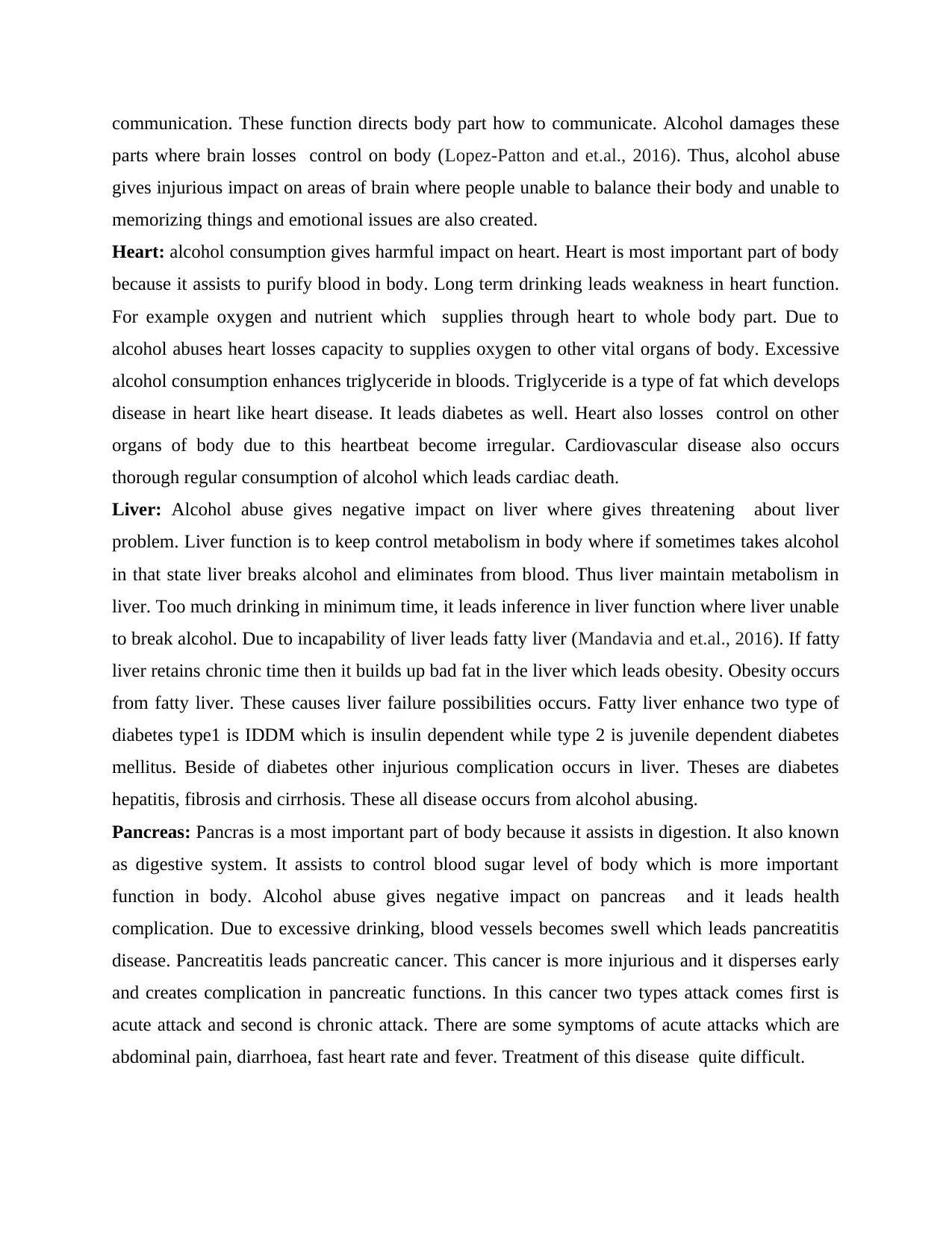
communication. These function directs body part how to communicate. Alcohol damages these
parts where brain losses control on body (Lopez-Patton and et.al., 2016). Thus, alcohol abuse
gives injurious impact on areas of brain where people unable to balance their body and unable to
memorizing things and emotional issues are also created.
Heart: alcohol consumption gives harmful impact on heart. Heart is most important part of body
because it assists to purify blood in body. Long term drinking leads weakness in heart function.
For example oxygen and nutrient which supplies through heart to whole body part. Due to
alcohol abuses heart losses capacity to supplies oxygen to other vital organs of body. Excessive
alcohol consumption enhances triglyceride in bloods. Triglyceride is a type of fat which develops
disease in heart like heart disease. It leads diabetes as well. Heart also losses control on other
organs of body due to this heartbeat become irregular. Cardiovascular disease also occurs
thorough regular consumption of alcohol which leads cardiac death.
Liver: Alcohol abuse gives negative impact on liver where gives threatening about liver
problem. Liver function is to keep control metabolism in body where if sometimes takes alcohol
in that state liver breaks alcohol and eliminates from blood. Thus liver maintain metabolism in
liver. Too much drinking in minimum time, it leads inference in liver function where liver unable
to break alcohol. Due to incapability of liver leads fatty liver (Mandavia and et.al., 2016). If fatty
liver retains chronic time then it builds up bad fat in the liver which leads obesity. Obesity occurs
from fatty liver. These causes liver failure possibilities occurs. Fatty liver enhance two type of
diabetes type1 is IDDM which is insulin dependent while type 2 is juvenile dependent diabetes
mellitus. Beside of diabetes other injurious complication occurs in liver. Theses are diabetes
hepatitis, fibrosis and cirrhosis. These all disease occurs from alcohol abusing.
Pancreas: Pancras is a most important part of body because it assists in digestion. It also known
as digestive system. It assists to control blood sugar level of body which is more important
function in body. Alcohol abuse gives negative impact on pancreas and it leads health
complication. Due to excessive drinking, blood vessels becomes swell which leads pancreatitis
disease. Pancreatitis leads pancreatic cancer. This cancer is more injurious and it disperses early
and creates complication in pancreatic functions. In this cancer two types attack comes first is
acute attack and second is chronic attack. There are some symptoms of acute attacks which are
abdominal pain, diarrhoea, fast heart rate and fever. Treatment of this disease quite difficult.
parts where brain losses control on body (Lopez-Patton and et.al., 2016). Thus, alcohol abuse
gives injurious impact on areas of brain where people unable to balance their body and unable to
memorizing things and emotional issues are also created.
Heart: alcohol consumption gives harmful impact on heart. Heart is most important part of body
because it assists to purify blood in body. Long term drinking leads weakness in heart function.
For example oxygen and nutrient which supplies through heart to whole body part. Due to
alcohol abuses heart losses capacity to supplies oxygen to other vital organs of body. Excessive
alcohol consumption enhances triglyceride in bloods. Triglyceride is a type of fat which develops
disease in heart like heart disease. It leads diabetes as well. Heart also losses control on other
organs of body due to this heartbeat become irregular. Cardiovascular disease also occurs
thorough regular consumption of alcohol which leads cardiac death.
Liver: Alcohol abuse gives negative impact on liver where gives threatening about liver
problem. Liver function is to keep control metabolism in body where if sometimes takes alcohol
in that state liver breaks alcohol and eliminates from blood. Thus liver maintain metabolism in
liver. Too much drinking in minimum time, it leads inference in liver function where liver unable
to break alcohol. Due to incapability of liver leads fatty liver (Mandavia and et.al., 2016). If fatty
liver retains chronic time then it builds up bad fat in the liver which leads obesity. Obesity occurs
from fatty liver. These causes liver failure possibilities occurs. Fatty liver enhance two type of
diabetes type1 is IDDM which is insulin dependent while type 2 is juvenile dependent diabetes
mellitus. Beside of diabetes other injurious complication occurs in liver. Theses are diabetes
hepatitis, fibrosis and cirrhosis. These all disease occurs from alcohol abusing.
Pancreas: Pancras is a most important part of body because it assists in digestion. It also known
as digestive system. It assists to control blood sugar level of body which is more important
function in body. Alcohol abuse gives negative impact on pancreas and it leads health
complication. Due to excessive drinking, blood vessels becomes swell which leads pancreatitis
disease. Pancreatitis leads pancreatic cancer. This cancer is more injurious and it disperses early
and creates complication in pancreatic functions. In this cancer two types attack comes first is
acute attack and second is chronic attack. There are some symptoms of acute attacks which are
abdominal pain, diarrhoea, fast heart rate and fever. Treatment of this disease quite difficult.
Paraphrase This Document
Need a fresh take? Get an instant paraphrase of this document with our AI Paraphraser
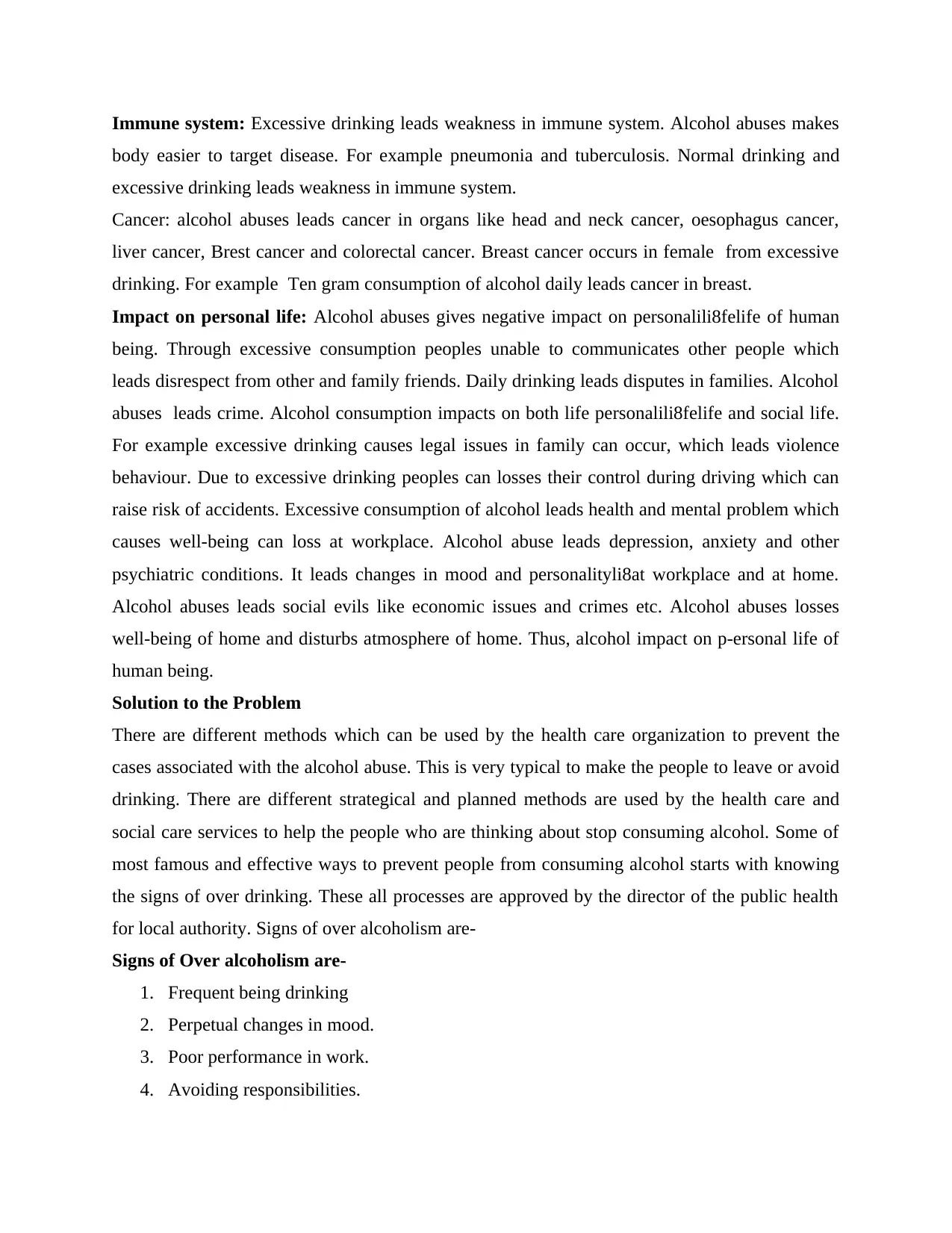
Immune system: Excessive drinking leads weakness in immune system. Alcohol abuses makes
body easier to target disease. For example pneumonia and tuberculosis. Normal drinking and
excessive drinking leads weakness in immune system.
Cancer: alcohol abuses leads cancer in organs like head and neck cancer, oesophagus cancer,
liver cancer, Brest cancer and colorectal cancer. Breast cancer occurs in female from excessive
drinking. For example Ten gram consumption of alcohol daily leads cancer in breast.
Impact on personal life: Alcohol abuses gives negative impact on personalili8felife of human
being. Through excessive consumption peoples unable to communicates other people which
leads disrespect from other and family friends. Daily drinking leads disputes in families. Alcohol
abuses leads crime. Alcohol consumption impacts on both life personalili8felife and social life.
For example excessive drinking causes legal issues in family can occur, which leads violence
behaviour. Due to excessive drinking peoples can losses their control during driving which can
raise risk of accidents. Excessive consumption of alcohol leads health and mental problem which
causes well-being can loss at workplace. Alcohol abuse leads depression, anxiety and other
psychiatric conditions. It leads changes in mood and personalityli8at workplace and at home.
Alcohol abuses leads social evils like economic issues and crimes etc. Alcohol abuses losses
well-being of home and disturbs atmosphere of home. Thus, alcohol impact on p-ersonal life of
human being.
Solution to the Problem
There are different methods which can be used by the health care organization to prevent the
cases associated with the alcohol abuse. This is very typical to make the people to leave or avoid
drinking. There are different strategical and planned methods are used by the health care and
social care services to help the people who are thinking about stop consuming alcohol. Some of
most famous and effective ways to prevent people from consuming alcohol starts with knowing
the signs of over drinking. These all processes are approved by the director of the public health
for local authority. Signs of over alcoholism are-
Signs of Over alcoholism are-
1. Frequent being drinking
2. Perpetual changes in mood.
3. Poor performance in work.
4. Avoiding responsibilities.
body easier to target disease. For example pneumonia and tuberculosis. Normal drinking and
excessive drinking leads weakness in immune system.
Cancer: alcohol abuses leads cancer in organs like head and neck cancer, oesophagus cancer,
liver cancer, Brest cancer and colorectal cancer. Breast cancer occurs in female from excessive
drinking. For example Ten gram consumption of alcohol daily leads cancer in breast.
Impact on personal life: Alcohol abuses gives negative impact on personalili8felife of human
being. Through excessive consumption peoples unable to communicates other people which
leads disrespect from other and family friends. Daily drinking leads disputes in families. Alcohol
abuses leads crime. Alcohol consumption impacts on both life personalili8felife and social life.
For example excessive drinking causes legal issues in family can occur, which leads violence
behaviour. Due to excessive drinking peoples can losses their control during driving which can
raise risk of accidents. Excessive consumption of alcohol leads health and mental problem which
causes well-being can loss at workplace. Alcohol abuse leads depression, anxiety and other
psychiatric conditions. It leads changes in mood and personalityli8at workplace and at home.
Alcohol abuses leads social evils like economic issues and crimes etc. Alcohol abuses losses
well-being of home and disturbs atmosphere of home. Thus, alcohol impact on p-ersonal life of
human being.
Solution to the Problem
There are different methods which can be used by the health care organization to prevent the
cases associated with the alcohol abuse. This is very typical to make the people to leave or avoid
drinking. There are different strategical and planned methods are used by the health care and
social care services to help the people who are thinking about stop consuming alcohol. Some of
most famous and effective ways to prevent people from consuming alcohol starts with knowing
the signs of over drinking. These all processes are approved by the director of the public health
for local authority. Signs of over alcoholism are-
Signs of Over alcoholism are-
1. Frequent being drinking
2. Perpetual changes in mood.
3. Poor performance in work.
4. Avoiding responsibilities.
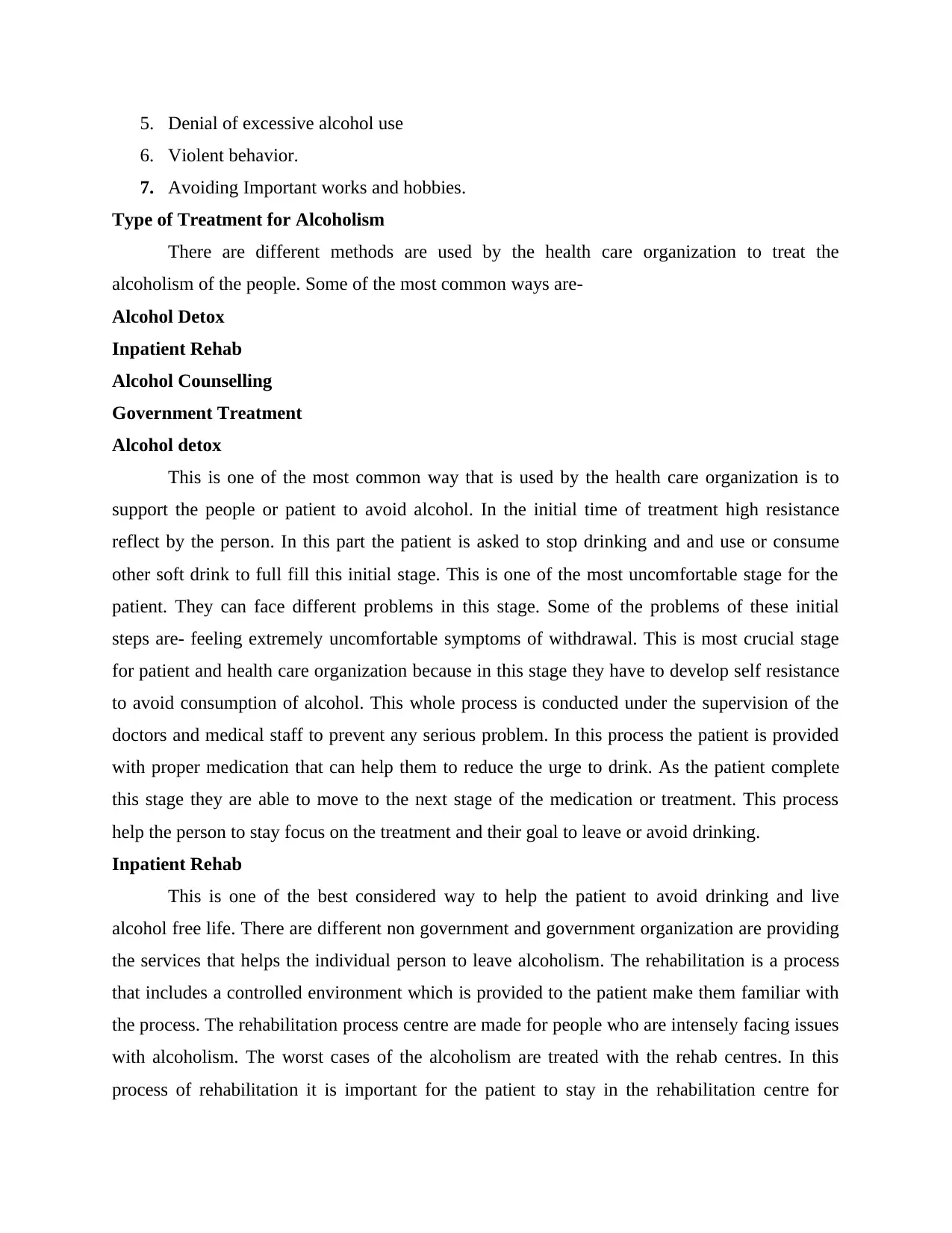
5. Denial of excessive alcohol use
6. Violent behavior.
7. Avoiding Important works and hobbies.
Type of Treatment for Alcoholism
There are different methods are used by the health care organization to treat the
alcoholism of the people. Some of the most common ways are-
Alcohol Detox
Inpatient Rehab
Alcohol Counselling
Government Treatment
Alcohol detox
This is one of the most common way that is used by the health care organization is to
support the people or patient to avoid alcohol. In the initial time of treatment high resistance
reflect by the person. In this part the patient is asked to stop drinking and and use or consume
other soft drink to full fill this initial stage. This is one of the most uncomfortable stage for the
patient. They can face different problems in this stage. Some of the problems of these initial
steps are- feeling extremely uncomfortable symptoms of withdrawal. This is most crucial stage
for patient and health care organization because in this stage they have to develop self resistance
to avoid consumption of alcohol. This whole process is conducted under the supervision of the
doctors and medical staff to prevent any serious problem. In this process the patient is provided
with proper medication that can help them to reduce the urge to drink. As the patient complete
this stage they are able to move to the next stage of the medication or treatment. This process
help the person to stay focus on the treatment and their goal to leave or avoid drinking.
Inpatient Rehab
This is one of the best considered way to help the patient to avoid drinking and live
alcohol free life. There are different non government and government organization are providing
the services that helps the individual person to leave alcoholism. The rehabilitation is a process
that includes a controlled environment which is provided to the patient make them familiar with
the process. The rehabilitation process centre are made for people who are intensely facing issues
with alcoholism. The worst cases of the alcoholism are treated with the rehab centres. In this
process of rehabilitation it is important for the patient to stay in the rehabilitation centre for
6. Violent behavior.
7. Avoiding Important works and hobbies.
Type of Treatment for Alcoholism
There are different methods are used by the health care organization to treat the
alcoholism of the people. Some of the most common ways are-
Alcohol Detox
Inpatient Rehab
Alcohol Counselling
Government Treatment
Alcohol detox
This is one of the most common way that is used by the health care organization is to
support the people or patient to avoid alcohol. In the initial time of treatment high resistance
reflect by the person. In this part the patient is asked to stop drinking and and use or consume
other soft drink to full fill this initial stage. This is one of the most uncomfortable stage for the
patient. They can face different problems in this stage. Some of the problems of these initial
steps are- feeling extremely uncomfortable symptoms of withdrawal. This is most crucial stage
for patient and health care organization because in this stage they have to develop self resistance
to avoid consumption of alcohol. This whole process is conducted under the supervision of the
doctors and medical staff to prevent any serious problem. In this process the patient is provided
with proper medication that can help them to reduce the urge to drink. As the patient complete
this stage they are able to move to the next stage of the medication or treatment. This process
help the person to stay focus on the treatment and their goal to leave or avoid drinking.
Inpatient Rehab
This is one of the best considered way to help the patient to avoid drinking and live
alcohol free life. There are different non government and government organization are providing
the services that helps the individual person to leave alcoholism. The rehabilitation is a process
that includes a controlled environment which is provided to the patient make them familiar with
the process. The rehabilitation process centre are made for people who are intensely facing issues
with alcoholism. The worst cases of the alcoholism are treated with the rehab centres. In this
process of rehabilitation it is important for the patient to stay in the rehabilitation centre for
⊘ This is a preview!⊘
Do you want full access?
Subscribe today to unlock all pages.

Trusted by 1+ million students worldwide
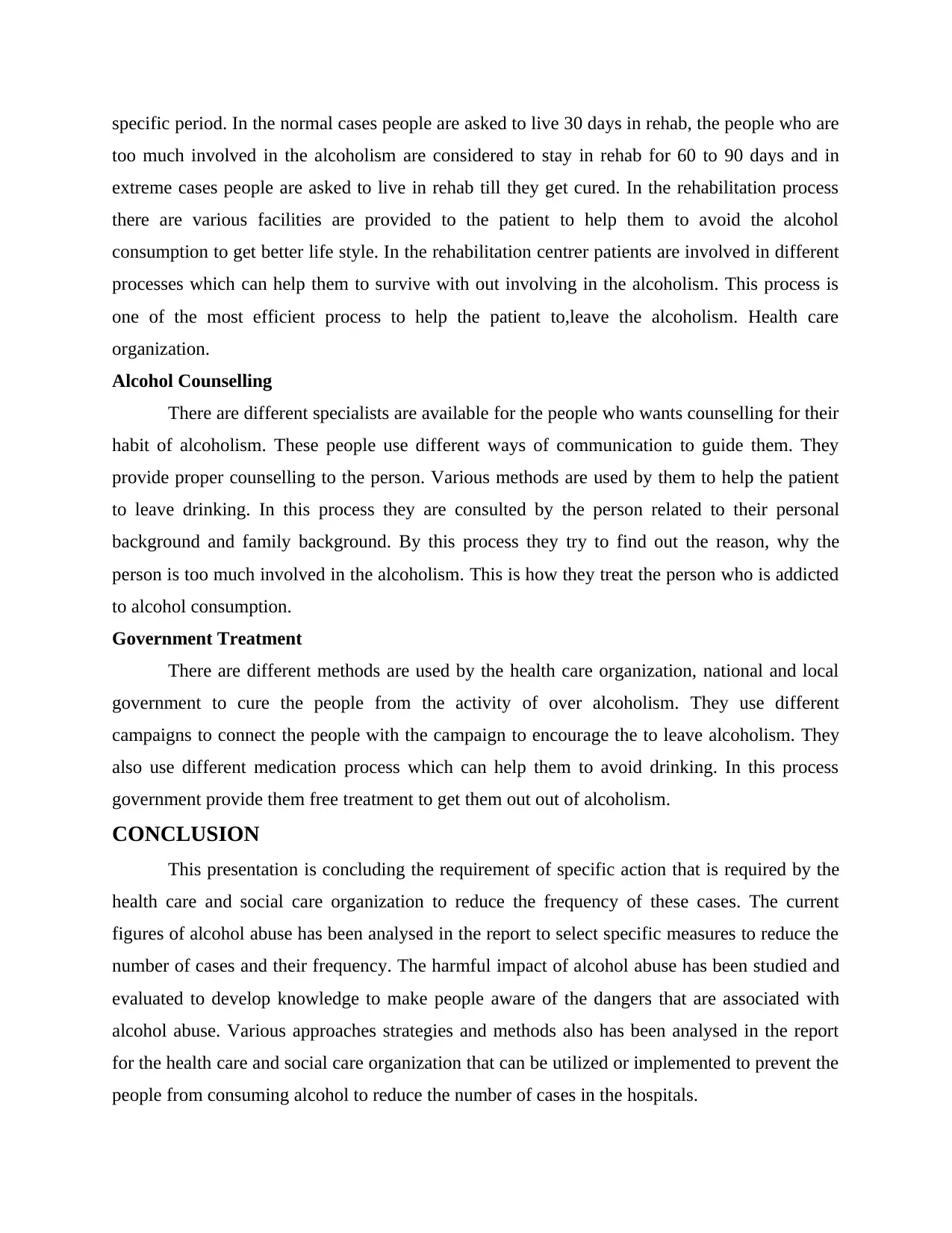
specific period. In the normal cases people are asked to live 30 days in rehab, the people who are
too much involved in the alcoholism are considered to stay in rehab for 60 to 90 days and in
extreme cases people are asked to live in rehab till they get cured. In the rehabilitation process
there are various facilities are provided to the patient to help them to avoid the alcohol
consumption to get better life style. In the rehabilitation centrer patients are involved in different
processes which can help them to survive with out involving in the alcoholism. This process is
one of the most efficient process to help the patient to,leave the alcoholism. Health care
organization.
Alcohol Counselling
There are different specialists are available for the people who wants counselling for their
habit of alcoholism. These people use different ways of communication to guide them. They
provide proper counselling to the person. Various methods are used by them to help the patient
to leave drinking. In this process they are consulted by the person related to their personal
background and family background. By this process they try to find out the reason, why the
person is too much involved in the alcoholism. This is how they treat the person who is addicted
to alcohol consumption.
Government Treatment
There are different methods are used by the health care organization, national and local
government to cure the people from the activity of over alcoholism. They use different
campaigns to connect the people with the campaign to encourage the to leave alcoholism. They
also use different medication process which can help them to avoid drinking. In this process
government provide them free treatment to get them out out of alcoholism.
CONCLUSION
This presentation is concluding the requirement of specific action that is required by the
health care and social care organization to reduce the frequency of these cases. The current
figures of alcohol abuse has been analysed in the report to select specific measures to reduce the
number of cases and their frequency. The harmful impact of alcohol abuse has been studied and
evaluated to develop knowledge to make people aware of the dangers that are associated with
alcohol abuse. Various approaches strategies and methods also has been analysed in the report
for the health care and social care organization that can be utilized or implemented to prevent the
people from consuming alcohol to reduce the number of cases in the hospitals.
too much involved in the alcoholism are considered to stay in rehab for 60 to 90 days and in
extreme cases people are asked to live in rehab till they get cured. In the rehabilitation process
there are various facilities are provided to the patient to help them to avoid the alcohol
consumption to get better life style. In the rehabilitation centrer patients are involved in different
processes which can help them to survive with out involving in the alcoholism. This process is
one of the most efficient process to help the patient to,leave the alcoholism. Health care
organization.
Alcohol Counselling
There are different specialists are available for the people who wants counselling for their
habit of alcoholism. These people use different ways of communication to guide them. They
provide proper counselling to the person. Various methods are used by them to help the patient
to leave drinking. In this process they are consulted by the person related to their personal
background and family background. By this process they try to find out the reason, why the
person is too much involved in the alcoholism. This is how they treat the person who is addicted
to alcohol consumption.
Government Treatment
There are different methods are used by the health care organization, national and local
government to cure the people from the activity of over alcoholism. They use different
campaigns to connect the people with the campaign to encourage the to leave alcoholism. They
also use different medication process which can help them to avoid drinking. In this process
government provide them free treatment to get them out out of alcoholism.
CONCLUSION
This presentation is concluding the requirement of specific action that is required by the
health care and social care organization to reduce the frequency of these cases. The current
figures of alcohol abuse has been analysed in the report to select specific measures to reduce the
number of cases and their frequency. The harmful impact of alcohol abuse has been studied and
evaluated to develop knowledge to make people aware of the dangers that are associated with
alcohol abuse. Various approaches strategies and methods also has been analysed in the report
for the health care and social care organization that can be utilized or implemented to prevent the
people from consuming alcohol to reduce the number of cases in the hospitals.
Paraphrase This Document
Need a fresh take? Get an instant paraphrase of this document with our AI Paraphraser
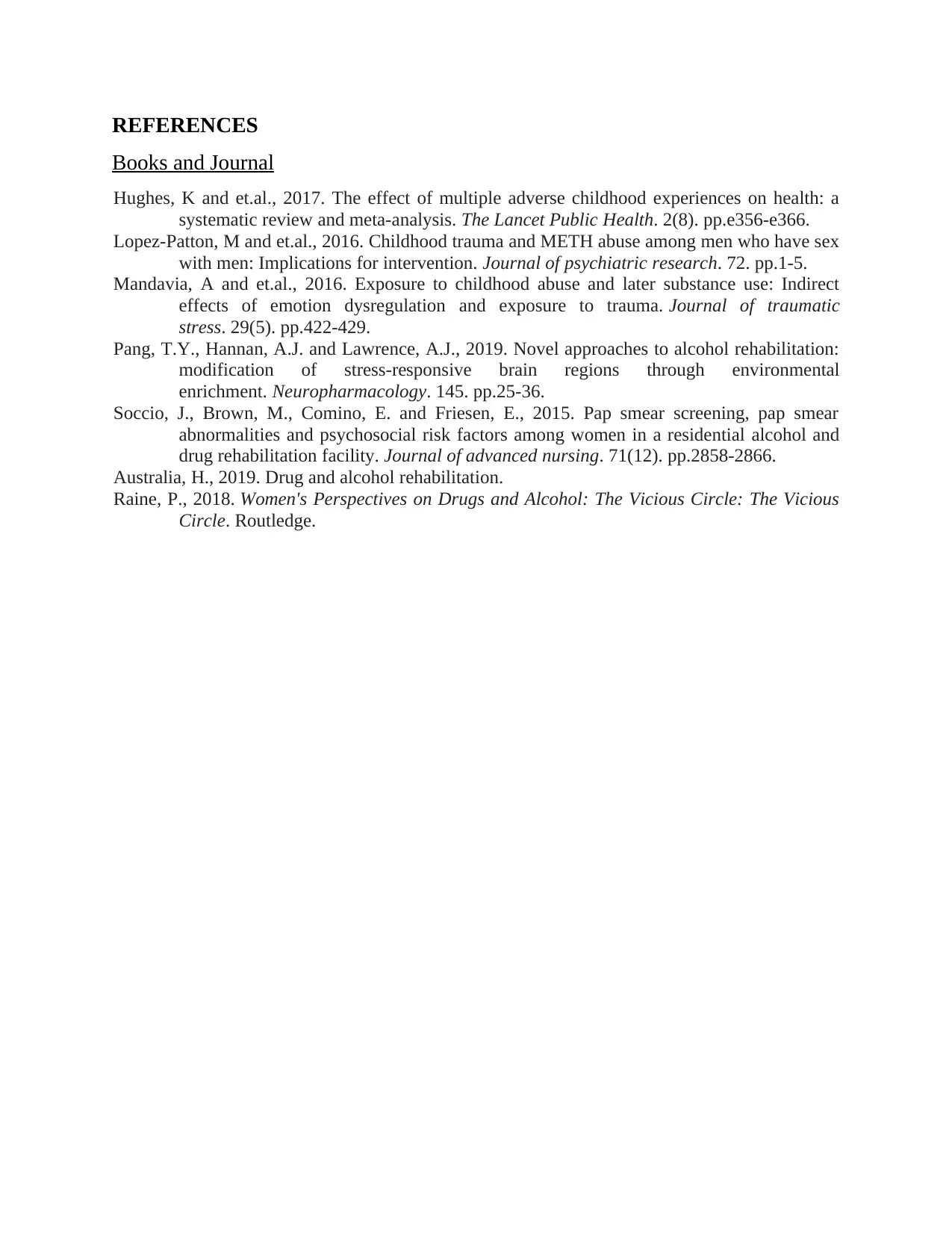
REFERENCES
Books and Journal
Hughes, K and et.al., 2017. The effect of multiple adverse childhood experiences on health: a
systematic review and meta-analysis. The Lancet Public Health. 2(8). pp.e356-e366.
Lopez-Patton, M and et.al., 2016. Childhood trauma and METH abuse among men who have sex
with men: Implications for intervention. Journal of psychiatric research. 72. pp.1-5.
Mandavia, A and et.al., 2016. Exposure to childhood abuse and later substance use: Indirect
effects of emotion dysregulation and exposure to trauma. Journal of traumatic
stress. 29(5). pp.422-429.
Pang, T.Y., Hannan, A.J. and Lawrence, A.J., 2019. Novel approaches to alcohol rehabilitation:
modification of stress-responsive brain regions through environmental
enrichment. Neuropharmacology. 145. pp.25-36.
Soccio, J., Brown, M., Comino, E. and Friesen, E., 2015. Pap smear screening, pap smear
abnormalities and psychosocial risk factors among women in a residential alcohol and
drug rehabilitation facility. Journal of advanced nursing. 71(12). pp.2858-2866.
Australia, H., 2019. Drug and alcohol rehabilitation.
Raine, P., 2018. Women's Perspectives on Drugs and Alcohol: The Vicious Circle: The Vicious
Circle. Routledge.
Books and Journal
Hughes, K and et.al., 2017. The effect of multiple adverse childhood experiences on health: a
systematic review and meta-analysis. The Lancet Public Health. 2(8). pp.e356-e366.
Lopez-Patton, M and et.al., 2016. Childhood trauma and METH abuse among men who have sex
with men: Implications for intervention. Journal of psychiatric research. 72. pp.1-5.
Mandavia, A and et.al., 2016. Exposure to childhood abuse and later substance use: Indirect
effects of emotion dysregulation and exposure to trauma. Journal of traumatic
stress. 29(5). pp.422-429.
Pang, T.Y., Hannan, A.J. and Lawrence, A.J., 2019. Novel approaches to alcohol rehabilitation:
modification of stress-responsive brain regions through environmental
enrichment. Neuropharmacology. 145. pp.25-36.
Soccio, J., Brown, M., Comino, E. and Friesen, E., 2015. Pap smear screening, pap smear
abnormalities and psychosocial risk factors among women in a residential alcohol and
drug rehabilitation facility. Journal of advanced nursing. 71(12). pp.2858-2866.
Australia, H., 2019. Drug and alcohol rehabilitation.
Raine, P., 2018. Women's Perspectives on Drugs and Alcohol: The Vicious Circle: The Vicious
Circle. Routledge.
1 out of 8
Related Documents
Your All-in-One AI-Powered Toolkit for Academic Success.
+13062052269
info@desklib.com
Available 24*7 on WhatsApp / Email
![[object Object]](/_next/static/media/star-bottom.7253800d.svg)
Unlock your academic potential
Copyright © 2020–2025 A2Z Services. All Rights Reserved. Developed and managed by ZUCOL.





